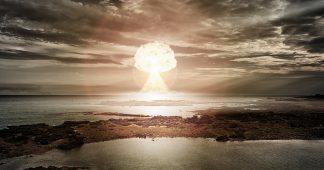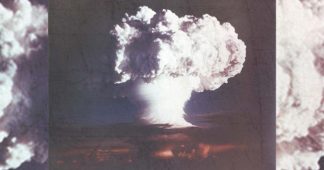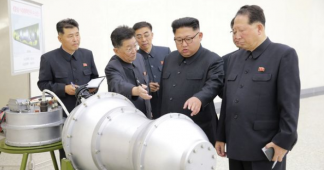Journal of Libertarian Studies,
Vol. IX, No. 2 (Fall 1990), pp. 69-78
Brian Martin
Contained in the legal systems of almost all modern liberal democratic states is the provision for extraordinary executive power to be exercised in emergencies. This power is variously called martial law, state of siege, constitutional emergency powers, and constitutional dictatorship. This power is designed for use both in the event of war and in the face of civil unrest, and many governments make extensive preparations for these contingencies.
Considering the scope and impact of constitutional emergency powers, remarkably little attention has been given to them by either supporters or critics of state power. One of the main reasons is that the problem seems remote in the lulls between emergencies, and also disturbing: Politicians certainly have nothing to gain by raising the issue.[1]
The 1980s saw an enormous upsurge in attention to the problem of nuclear war. Yet while accounts of the physical effects of nuclear war have been innumerable, there has been little mention of the likely political aftermath of a nuclear crisis or war: the problem of constitutional dictatorship in the nuclear age. This topic is my concern here.
To justify the examination of politics during and after a nuclear crisis or war, it is first necessary to show the significant possibility that these can occur without total destruction of human society. That is my first task. After a mention of some of the connections between war and political economy, I focus on “war dictatorship,” namely, the subordination of societies to authoritarian states, which is a likely political consequence of nuclear crisis. Finally, I spell out a few implications of the analysis for social action to avoid the worst political consequences of nuclear crisis and war.
Can the World Survive a Major Nuclear Crisis?
Especially in the past several years, an enormous amount of attention has been given to the physical consequences of nuclear war, much of it emphasizing the possibility of global annihilation. The impression given is that once any sort of nuclear war occurs, there is really nothing further to consider.
My argument here is simple. Whatever the likelihood that a major nuclear confrontation will result in total annihilation of the earth’s population, a significant possibility remains that nuclear crisis or war will leave major portions of the world’s population alive and, for the most part, unaffected physically. If this is the case, then it is worth considering post-crisis and post-war politics.
Three types of scenarios are worth noting: nuclear crisis, limited nuclear war, and global nuclear war. First, nuclear crisis: It is possible to imagine the development of a major nuclear confrontation short of nuclear war. This might be an extended nuclear emergency, like the 1962 Cuban missile crisis, yet more serious and prolonged. It could lead to declarations of martial law and changes in political structures, as described below, that might well persist beyond the nuclear crisis itself.
Second, limited nuclear war: A nuclear war does not have to be global in extent. Such a war might be limited geographically – for example, to the Middle East – or restricted to the exchange of a few tactical or strategic nuclear weapons. Many analysts argue that it would be difficult to keep a nuclear exchange limited, but these arguments remain to be tested: There is no evidence of actual nuclear wars to prove or disprove them. It is worth remembering that expert predictions concerning wars (for example, that World War I would be over quickly) have often been quite wrong.
It is also possible to imagine a “successful” first strike, for example, using a few high-altitude explosions over a country to disable electronics through the electromagnetic pulse, thereby putting the enemy’s command and control systems out of commission. However unlikely the success of such a tactic, it cannot be ruled out a priori.
Third, global nuclear war: If a nuclear war does escalate to major exchanges, does that mean that near or actual human extinction is certain? The available evidence is by no means conclusive. Although since the 1950s many people have believed that nuclear war will inevitably lead to the death of most or all the people on earth, the scientific evidence to support this belief has been skimpy and uncertain. The only mechanism currently considered to create a potential threat to the survival of the human species is the global climatic effects of smoke and dust from nuclear explosions, commonly called nuclear winter.[2] Even here, some scientists believe the effects will be much more moderate than initially proclaimed.[3] My assessment is that global nuclear war, while containing the potential for exterminating much of the world’s population, might kill “only” some hundreds of millions of people – an unprecedented disaster to be sure, but far short of global annihilation.
War and Political Economy
The relationship of war to the political and economic power relations in a society is not a simple or automatic one. For one thing, there is a mutual interaction between social structure and the type of war and military organization involved.[4] For example, highly technological warfare fosters and is fostered by an advanced industrial economy with highly trained personnel, usually full-time professionals, to design and plan the manufacture and deployment of weapons systems. While there are many connections between war and social relations, the focus here will be on some broad relations between war and the modern state.
War as State-Building
Modern war has been closely connected with the building of modern states. The modern state is built on a centralization of power once held by local entities, such as feudal estates. As trade broke down the local and regional economic independence several hundred years ago in Europe, the political basis for feudal rule was likewise undermined since the estates could no longer support adequate expenditures for defense. One of the early functions and motivations for development of state bureaucracies was establishing and administering military forces. In short, as local economic self-reliance declined, defense against external military threats passed to the developing states, whose powers were expanded to maintain military strength. Most major social revolutions have been associated with war or the threat of it.[5] For example, one factor in the development of the French Revolution was the burden of military spending carried by the Old Regime, which faced military competition both on sea and land. Finances for this burden could not be raised in the context of the prerevolutionary social relations. The Revolution itself led to a powerful new state apparatus that enabled mass mobilization of the population for making war, and the military successes of the new French state played a major role in the creation and strengthening of other states throughout Europe. The Russian Revolution was made possible by the exhaustion of the Tsarist state and military forces in World War I. The Provisional government sealed its doom by continuing to fight in this war. The pattern of centralization of power by the Bolsheviks was greatly hastened by the civil war of 1918-1920. In the past fifty years, numerous new states have gained their independence in wars fought against colonial powers. The methods of guerrilla warfare, which involve mobilizing peasants for both war-making and smashing traditional social relationships, have played an important role in shaping the political and economic institutions of these new states.
Centralized Power
Wars are fought by armies on behalf of states. Modem wars, especially those wars requiring total mobilization of a society’s resources, have required a centralization of power by the state. As Randolph Bourne said during World War I, “War is the health of the state”. It has often been noted that capitalist economies are transformed into command economies in times of major war.[6] This transformation occurs because the market breaks down. Not everyone wants to do precisely what is needed to support the war effort. For example, conscription is a non-market means for building an army: There are too many people for whom no payment would be sufficient to induce them to become soldiers. In place of financial inducements and inevitable inflation, state coercion is used to manipulate or control the pattern of investment and distribution. During wartime, power passes from capitalists to state bureaucracies. The experiences of wartime can have a lasting impact on capitalist economics by providing experiences and models for peacetime government involvement in the economy. Since World War II, military expenditures have remained at a higher level than after previous wars, providing a permanent avenue for government intervention in the economy.[7] This process has been accompanied by the expansion of state bureaucracies in areas such as medical care, education, and social welfare services. In the Third World, the penetration of Western economic systems is promoted by the military forces, which serve as models for state bureaucratization. Military forces and military mobilization play a central role in the creation and survival of communist states. One reason that communist economies are so geared for war is that they are built on a military model, as well as being forged in war. When the Communist state is threatened by revolts from below, the army may step in to maintain existing social relations and, in particular, to preserve state power. This intervention has been most apparent in China during the Cultural Revolution and again in 1989, and in Poland after martial law was declared in 1981. Of course, direct military intervention in Third World countries has become more the rule than the exception. Military takeovers in developed capitalist states also occur, as in Portugal and Greece.
Technology
Modern warfare has become highly technological. More important than commitment and loyalty by soldiers is state research and development and implementation of new technologies. The keys to modem war are technical expertise and bureaucratic management of the technological process. In earlier eras, technologies for fighting were simple – for example, the rifle and bayonet. Workers and peasants could fight using the weapons of their rulers, and with a reasonable chance of success. This is no longer true. The expert knowledge and professional training utilized by modern military forces is not available to opposition groups. Modern weapons are so lethal that the chances of success in urban guerrilla warfare are minimal.[8] The social relations embodied in modern technology favor the continued dominance of state elites. Nuclear weapons are the epitome of technology created and deployed by states that cannot be readily used by opponents of the state.
The Problem of War Dictatorship
One of the first casualties of war is political freedom. This fact is seen most clearly in the liberal democracies, where these freedoms are widely touted, although institutional realities often restrict their applicability. In wartime, it is common for martial law (in common law countries) or a “state of siege” (in civil law countries) to be introduced. Police and other public officials are given arbitrary powers to arrest and punish people without trial, to undertake searches and seizures without warrant, to forbid public meetings, to set curfews, to suppress freedom of speech and the press and to institute courts-martial for the summary trial of crimes against the state.
In wartime state power dramatically increases, and in particular the power of the executive increases, typically that of the cabinet in parliamentary systems and of the president in presidential systems. The methods by which “constitutional dictatorship” are introduced vary from country to country and situation to situation. In some countries, such as France, the provisions for a state of siege are written into the constitution, whereas elsewhere, in the United States, for example, ad hoc measures have been taken by the executive and usually legitimized later by the legislature.[9]
It has often been remarked that the past century has seen a gradual increase in the power of the central governments. The relatively short periods of emergency rule in wartime, with dramatic increases in state powers over political and economic life, are usually followed by a return to “normalcy,” but with some more lasting transfer of power to the state executive. In the United States for example, the Civil War and the two world wars each led to increased power for the president, and each of these wars is associated (usually favorably) with a “strong” president. These wars also led to a much wider role of the government in the economy. George Orwell’s 1984, often seen solely as an indictment of Communism, captures an important truth about wider political trends in this century: the close association of war with political repression. The rise (or manufacture) of the cold war in the late 1940s allowed a continuing mobilization of military force and spending that is historically quite atypical of “interwar” periods. The military has obtained a more permanent stake in national economies, and this seems to be associated with a number of other indicators of the potential for state repression, most notably the increased role of secret police.[10] It has not gone unnoticed that the dictatorial powers taken on by governments in wartime are precisely the same powers that are needed to defend property and privilege against demands from the working class and other oppressed groups: “Every device of constitutional dictatorship is in its nature ideally suited to be employed as a weapon of reaction and class struggle.”[11] Historically, emergency powers have been used in three types of situations: war, economic collapse, and an emergency threatening state power. The powers given to the United States government during the New Deal illustrate the use of emergency powers to deal with economic collapse. The British Emergency Powers Act of 1920, designed to deal with strikes, illustrates the use of emergency powers to deal with a threat to the state that was also a challenge from the working class against capital. During most of the period of the Weimar Republic in Germany, 1919-1933, Article 48 in the constitution, an emergency powers provision, was used regularly to govern the country. But because the German army was reactionary, Article 48 could be invoked only against challenges from the left.[12] From the point of view of liberal democratic theory, constitutional dictatorship is a necessary evil: Occasionally it is necessary to suspend liberal democracy in order to protect it in the long run. In practice this is what has happened on a number of occasions. After the ends of wars, such as the world wars, emergency powers have been relinquished by governments. But this procedure does not always work. In the words of Carl J. Friedrich, “there are no ultimate institutional safeguards available for insuring that emergency powers be used for the purpose of preserving the constitution.”[13] The number of military dictatorships imposed by invoking emergency powers designed to protect democracy is too great to enumerate. Various constitutional guarantees can be developed to limit the use of martial law and to contain the abuses that tend to develop under it, and no doubt much remains to be done in this direction.[14] But as I will argue below, it is less the formal limitations on emergency rule that contain it than popular resistance to its extension beyond clear emergency conditions. What preparations have states made for political control in a nuclear emergency? It is not possible to provide a comprehensive answer since much of the relevant information is kept secret. But the available evidence shows a variety of degrees and methods of preparation. Sweden and Switzerland have made the most comprehensive preparations for survival of both the population and the state. Civil defense systems in these two countries are extensive, with the capability of protecting most of the population from fallout, if not direct attack. In Switzerland, the bulk of the armed forces comes from the militia rather than a standing army. In Sweden, a strong conventional military system is supplemented by protection and dispersal of economic production, psychological preparation of the population, and some training in civilian resistance to aggression. In both these countries these preparations are largely supported by the population.[15] British government preparations for nuclear war provide a strong contrast. British civil defense plans provide little protection for the population but include numerous citadels and shelters to ensure the survival of government functions. The basic thrust of planning seems to be to maintain government control over the population rather than maximum survival or protection. For example, simulations organized to train civil defense personnel and postwar executives are often aimed more at internal dissent than at “enemy” attackers. The mentality of the officials who would be in control of martial law in the event of a nuclear crisis is shown by their characterization of “pacifism” as a cover for subversion. These plans would be virtually unknown if it were not for the efforts of a few meticulous investigators like Peter Laurie and Duncan Campbell.[16] It is not known to what extent similar preparations have been made in other European countries. Campbell mentions that some of them have plans to suppress public dissent and the movement of refugees. In the United States, preparations seem to be less developed, though the Federal Emergency Management Agency seems to have been making a bid for increased power both in executive rule in emergencies and in current “counterterrorism.”[17] The Australian government, by contrast, seems to have made almost no preparations for a nuclear crisis or the aftermath of nuclear war. The Australian Defence Department has carried out no substantial studies of the effect of nuclear war on Australia, and there is no active civil defense program. The War Book, a government guide for official action in the event of war, has not been updated since the 1950s.[18] The different degrees and types of preparations by governments for their own survival and the survival of their populations grow out of their own political and institutional histories, including the degree of government centralization and secrecy, the interactive dynamics of government bureaucracies, relationships with nuclear weapons states, and the saliency of nuclear threats. These issues are not my main concern here. Rather, the point is that post-nuclear war planning has been carried out by some governments, and in some cases a key focus in this planning is more on maintaining internal political control than defending against external enemies or protecting the population.
Responses
If we examine earlier experiences of war dictatorship, an intriguing question arises: What is it that prevents the continuation of the dictatorship after the removal of the justifying emergency, namely the war? In a state of martial law the executive has ultimate power over both the political and economic system, and the police and military are the agents of the executive to enforce its will, by force if necessary. Certainly there is no countervailing force backed by violence that could terminate these dictatorships in countries such as Britain, France, and the United States. The liberal answer to this question seems to be that respect for constitutional requirements by the executive prevents the extension of the dictatorship.[19] But even for liberals the problem is a difficult one. Lasswell, in an essay on balancing the need to prevent aggression from “totalitarian dictatorships” against the need to protect freedoms endangered by rise of a police state in the United States, argued that vigilance to protect freedoms was needed from the executive, Congress, the courts, and the public.[20] A close look at the termination of executive powers after wars gives a better picture of what actually happens. In some cases a voluntary termination of the powers does occur, but the driving force in other cases is widespread public refusal to accept continuation of repressive executive power. For example, British prime minister Lloyd George continued with the administrative innovation of the war cabinet for some time after the end of World War I, but finally was induced to give it up in October 1919 in the face of public criticism. After the end of World War II, demands by soldiers from Allied countries to come home were so insistent that Western governments could not ignore them. Remobilization became possible only after the Soviet Union had been turned from an ally into an enemy in the eyes of the public. This sort of popular opposition to government emergency powers can occur during wartime as well. In both Britain and France at the beginning of World War I, plans were made for a complete system of military courts to deal with infractions of executive orders. After the immediate threat of German victory receded, popular pressure (given expression, for example, in the legislature) against the harshness and abuses of these courts resulted in a significant reduction in their powers.[21] These experiences of the moderation or elimination of wartime dictatorial powers by popular opposition can be seen as examples of the power of nonviolent action.[22] Nonviolent action includes actions such as demonstrations, fraternization, social ostracism, strikes, work-to-rule, boycotts, sit-ins and parallel government, among a host of other actions. There are many historical examples in which nonviolent action has been the main force bringing down repressive regimes, including in recent years the Greek, Iranian, Argentine, and Philippine governments. Although the Ebert government invoked Article 48 against left-wing threats to the Weimar Republic, it could not rely on its own military to oppose the right-wing Kapp putsch in 1920. Instead, the German population spontaneously used mass nonviolent action to topple Kapp and restore the republic.[23] Liberal democratic political theory, with its focus on representative institutions in a pluralist and constitutional system, has not been very useful in understanding these events, which involve mass action and non-cooperation to undermine the loyalty of troops and functionaries to the political and military elites. Marxist theory has not had a lot to say either, because such mass action does not result in any significant change in the organization of production, in many cases, the class composition or orientation of rulers. As an organized counterweight to war dictatorship, perhaps most promising is social defense, also called civilian defense, civilian-based defense, and nonviolent defense.[24] Social defense is nonviolent resistance to aggression as an alternative to military defense, using methods such as strikes, boycotts, noncooperation, demonstrations, and setting up alternative institutions. No society has yet adopted social defense, but some examples of the spontaneous use of nonviolent methods give a suggestion of its possibilities, such as the Czechoslovak resistance to the Soviet invasion of 1968 and the toppling of the dictatorship in Guatemala in 1944. Social defense relies on community solidarity and widespread participation, and by its nature is suited for opposing state military power. Preparations for social defense against an external enemy would serve as well for opposing state or military repression in the event of nuclear crisis or war. Economic organization plays a large role in social defense. Many of the methods of nonviolent resistance are economic in nature, such as strikes, boycotts, and work-ins. Factories and other economic resources can be designed so that they can be shut down or redirected to resist use by an aggressor. For example, large scale machinery can be designed with key components, hard to duplicate, whose easy removal or destruction halts its operation. Replacements could be kept in a safe place, perhaps even another country, so that even torture of workers would not restore production. Whatever the advantages of social defense as a defense system by itself or as a backup to military defense, or in preventing the excesses of war dictatorship, it has not been enthusiastically received by governments. Only a few governments, including Sweden and the Netherlands, have even sponsored serious investigations into the option. This is not surprising: Most governments are loath to sponsor any initiative that might be used to undermine their own powers. Although the existence of nuclear weapons has stimulated vast amounts of political theorizing, hardly anything has been done concerning the political consequences of nuclear crisis or nuclear war. In my opinion, the prospect of a nuclear crisis serious enough to cause severe political repression is real enough to warrant some political preparation as an insurance policy. The goal should be to make this preparation of a type that also reduces the risk of nuclear war in the first place.[25]
NOTES
1. Frederick Mundell Watkins, The Failure of Constitutional Emergency Powers under the German Republic (Cambridge, Mass.: Harvard University Press, 1939), 24, 137. 2. Paul Ehrlich et al, The Cold and the Dark (New York: Norton, 1984). 3. Starley L. Thompson and Stephen H. Schneider, “Nuclear winter reappraised”, Foreign Affairs 64 (Summer 1986): 981-1005. 4. Stanislav Andreski, Military Organization and Society (London: Routledge and Kegan Paul, 1968). 5. Theda Skocpol, States and Social Revolutions (Cambridge: Cambridge University Press, 1979). 6. John Burnham, Total War: The Economic Theory of a War Economy (Boston: Meador, 1943); Lionel Robbins, The Economic Problem in Peace and War (London: Macmillan, 1950). 7. Seymour Melman, The Permanent War Economy: American Capitalism in Decline (New York: Simon and Schuster, 1974). 8. Martin Oppenheimer, The Urban Guerilla (Chicago: Quadrangle, 1969). 9. Clinton L. Rossiter, Constitutional Dictatorship: Crisis Government in the Modem Democracies (Princeton: Princeton University Press, 1948). 10. Bertram Gross, Friendly Fascism: The New Face of Power in America (New York: M. Evans, 1980). That this is nothing new, see among others, Arthur Selwyn Miller, Democratic Dictatorship: The Emergent Constitution of Control (Westport, Conn.: Greenwood, 1981). 11. Rossiter, Constitutional Dictatorship, 173. 12. Watkins, Failure of Constitutional Powers. 13. Carl J. Friedrich, Constitutional Government and Democracy: Theory and Practice in Europe and America, 4th ed. (Waltham, Mass.: Blaisdell, 1968), 570. 14. Frederick M. Watkins, “The Problem of Constitutional Dictatorship,” Public Policy 1 (1940): 324-379. 15. Adam Roberts, Nations in Arms (New York: Praeger, 1976). 16. Peter Laurie, Beneath the City Streets: A Private Investigation into Government Preparations for National Emergency (Frogmore: Granada, 1979); Duncan Campbell, War Plan UK: The Truth About Civil Defence in Britain (London: Burnett, 1982). 17. Keenen Peck, “The Take-Charge Gang,” Progressive, May 1985, 17-24; Diana Reynolds, “FEMA and the NSC: the rise of the national security state,” CovertAction Information Bulletin 33 (Winter 1990): 54-58; Edward Zuckerman, The Day After World War III (New York: Viking, 1984). 18. Desmond Ball, “The Australian Defense Force and Mobilisation”, in Desmond Ball and J. O. Langtry, eds., Problems of Mobilisation of Defence of Australia (Canberra: Phoenix Defence Publications, 1980), 9-23. 19. Rossiter, Constitutional Dictatorship. 20. Harold D. Lasswell, National Security and Individual Freedom (New York: McGraw-Hill, 1950). 21. Rossiter, Constitutional Dictatorship. 22. Gene Sharp, The Politics of Nonviolent Action (Boston: Porter Sargent, 1973). 23. Watkins, Failure of Constitutional Powers, 37. 24. See for example Adam Roberts, ed., The Strategy of Civilian Defence: Non-Violent Resistance to Aggression (London: Faber and Faber, 1967); Anders Boserup and Andrew Mack, War Without Weapons (London: Frances Pinter, 1974); Gene Sharp, Making Europe Unconquerable (Cambridge, Mass.: Ballinger, 1985). 25. Brian Martin, “How the Peace Movement Should be Preparing for Nuclear War,”Bulletin of Peace Proposals 13 (1982): 149-159.











